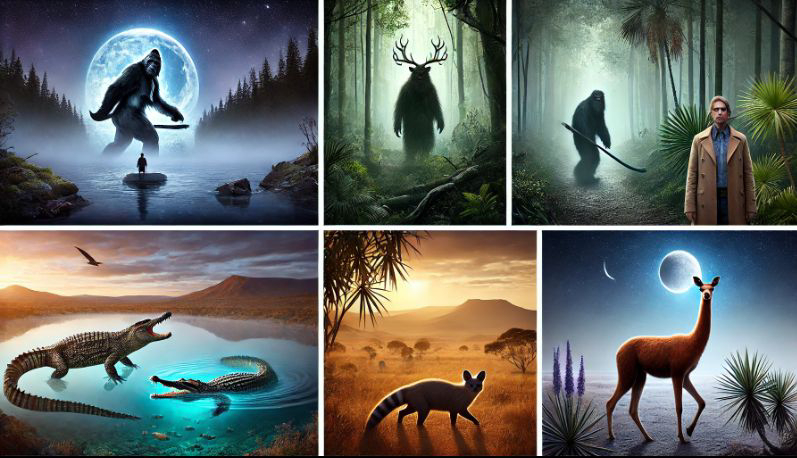The Top 5 Cryptids That Might Actually Be Real
Cryptids, mysterious creatures whose existence remains unverified by science, have captivated human imagination for centuries. While many remain steeped in folklore, some have gathered intriguing evidence suggesting they could be real. Here are five cryptids that may actually exist, with supporting evidence and sources.
1. Sasquatch/Bigfoot
Sasquatch, also known as Bigfoot, is one of the most famous cryptids in North America. Eyewitness accounts, footprint casts, and strange audio recordings continue to provide tantalizing clues to its existence.
Eyewitness Accounts: Thousands of credible reports describe encounters with a large, bipedal creature. These include testimonies from hunters, park rangers, and law enforcement officers.
Footprint Evidence: Dr. Jeff Meldrum, a professor of anatomy and anthropology at Idaho State University, has examined numerous Sasquatch footprint casts that display unique characteristics, including dermal ridges.
Sasquatch Sounds: The famous "Sierra Sounds," recorded by Ron Morehead, have been analyzed by bioacoustic experts. Some researchers believe they could represent a complex language used by Sasquatch.
For further details, see:
2. The Loch Ness Monster
Known as "Nessie," the Loch Ness Monster has been reported in Scotland's Loch Ness for centuries. While most believe Nessie is a myth, some modern evidence suggests it could be a real creature, possibly a surviving marine reptile like a plesiosaur.
Sonar Evidence: In 2011, a sonar-imaging project detected a 5-foot-long object moving beneath a boat in Loch Ness at a depth of 75 feet. Other similar sonar findings add to the mystery.
Eyewitness Sightings: Numerous sightings describe a large, long-necked creature. Some of these sightings date back to the early 20th century and continue to this day.
For more info, go to:
3. Mokele-Mbembe
The Mokele-Mbembe, reportedly living in the Congo River Basin, is often described as a large, long-necked creature resembling a sauropod dinosaur. Indigenous tribes and various expeditions report sightings of this mysterious animal.
Local Accounts: Many tribes in the Congo describe Mokele-Mbembe as a large creature with a long neck and tail, resembling a dinosaur. Their descriptions have remained consistent over time.
Expeditions and Reports: Cryptozoologists like Roy Mackal have led expeditions into the Congo to investigate the creature. While no conclusive evidence has been found, there are multiple credible reports of sightings by locals and explorers alike.
For more on Mokele-Mbembe, visit:
4. Chupacabra
The Chupacabra, first reported in Puerto Rico in the 1990s, is said to attack livestock and drain them of blood. Described as either a reptilian creature with spikes or a hairless, dog-like animal, the Chupacabra has sparked interest worldwide.
Animal Carcass Evidence: Farmers have discovered livestock killed with precise puncture wounds and drained of blood. While some cases can be explained by natural predators, the method of attack remains unusual.
Biological Evidence: In Texas and other parts of the U.S., strange, hairless animals resembling Chupacabras have been captured. DNA analysis has sometimes shown them to be mangy coyotes, but the unusual characteristics of these animals have kept the mystery alive.
To learn more, check out:
5. Thylacine (Tasmanian Tiger)
The Thylacine, a carnivorous marsupial native to Australia and Tasmania, was declared extinct in the 1930s after the last known individual died in captivity. However, hundreds of sightings have been reported since, leading some to believe the Thylacine may still be alive.
Eyewitness Reports: Numerous sightings of Thylacines have been reported in both Tasmania and mainland Australia since their official extinction. In 2016, footage captured by camera traps in Australia sparked new interest in the possibility of the Thylacine's survival.
DNA Studies: Scientists have been able to extract DNA from preserved Thylacine specimens, and there are ongoing efforts to explore whether it might be possible to bring this species back through de-extinction efforts.
For more info, go to:
While science remains cautious about the existence of these cryptids, evidence continues to accumulate in the form of eyewitness accounts, physical traces, and biological analyses. As technology improves, there may come a day when these creatures step out from the shadows of myth into the light of reality.

